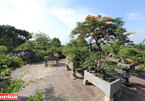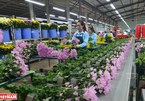 |
| An orchid garden belonging to a high-tech agriculture company in the northern province of Ha Nam. — VNA/VNS Photo Dai Nghia |
Many localities have defined it as an important new economic sector and introduced measures to encourage its development.
To date, Vietnam has about 35,000 hectares of specialised cultivation of ornamental plants and flowers, excluding small-scale household farms.
From 2005 to 2015, the sector's output value increased by 7.2 times, reaching VND6.5 trillion (US$281.2 million), of which export turnover was more than US$60 million.
Tran Xuan Dinh, former deputy director of Cultivation Department, said flowers and ornamental plants were considered a key commodity in the restructuring of the crop sector.
Geographical location, soil conditions, climate, and the ingenuity and dedication of Vietnamese growers were great advantages in the development of flowers and ornamental plants, Dinh said.
In addition, the production of ornamental plants and flowers does not require much land, irrigation water, fertilisers or pesticides. It's easy to apply new technologies while providing much higher incomes than other conventional crops under the same conditions.
Due to such high economic efficiency, many farms growing ornamental flowers and bonsai trees have been formed in Hanoi, HCM City and the provinces of Lao Cai, Hung Yen, Nam Dinh, Binh Dinh, Lam Dong and Dong Thap, with a turnover from VND800 million (US$35,000) to VND2.5 billion ($109,0000) per hectare per year.
According to the Institute of Vegetable and Fruit Research under the Ministry of Agriculture and Rural Development, demand for flowers and bonsai trees in the market is increasing strongly.
In the last five years, the average demand for the products rose by about 15 per cent each year.
Over the past years, the production and trading of flowers and ornamental plants have contributed to the export turnover of more than $4 billion of the vegetable and fruit industry, contributing to restructuring cultivation patterns, creating more jobs and improving the living environment.
Hanoi has developed more than 6,000 hectares of specialised cultivation of flowers and ornamental plants in 11 traditional villages.
The city has also identified four flowers and ornamental plant products as key products to encourage investment, namely orchids, roses, lilies and peaches.
“Thanks to using new and highly-productivity seedlings, advanced fertilisation procedures, mineral nutrition and automatically adjusted light and temperature systems, the yield of flowers and ornamental plants in the city is continuously increasing,” said Nguyen Van Chi, director of the Hanoi Rural Development Sub-department.
“The average production value reached VND500 million to VND1.5 billion ($21,635-64,906) per hectare per year. Notably, some farms reached VND2.5 billion (US$95,000) per hectare,” Chi said.
As flowers and ornamental plants are seen as key products, Hanoi has helped the growers invest in the improvement of flowers and ornamental plant quality.
The city is also one of the leading localities in the country in the certification of flower products under the One Commune One Product (OCOP) programme, according to Chi.
This helps boost the trade of flowers and ornamental plants across the country, he said.
Although positive initial results have been achieved, the development of flowers and ornamental plants in Hanoi and indeed the entire country still has shortcomings.
The main issue is that flower and ornamental plant production has not yet developed stably and sustainably in the value chain, according to Prof. Nguyen Quang Thach, an expert from the Vietnam Academy of Agricultural Sciences.
“Production is not tied to market requirements. Policy approaches, especially loans to invest in the development of this sector, are still complicated,” Thach said.
Many experts and managers also believe that policies to support the development of flowers and ornamental plants are available but accessing them has proven difficult.
Planning work for areas specialising in growing flowers and ornamental plants to develop has not been paid much attention by many localities.
“The potential of flower and ornamental plant growing had not been able to thrive, partly due to policies,” said Prof. Tran Duy Quy, president of the Vietnam Rural Development Association.
“We do not yet have a suitable tax policy to promote the high-tech flower growing industry to develop with its inherent potential,” Quy said.
“Currently, there is a lack of advanced production technology to produce flowers towards high-tech close production lines from growing to harvesting, preserving and processing,” Quy said.
“In this respect, flower growers need help and technology transfer. Moreover, the fact that most of the flower varieties being grown in Vietnam are imported unofficially, so there is no copyright of the plants so they can't be exported,” he said.
To develop flowers and ornamental plants, the Government and ministries should improve production support policies, focusing on land accumulation, vocational training, advanced technical and technological transfer, and expansion of large-scale specialised production areas, Quy suggested.
Meanwhile, Dr. Dao The Anh, vice director of the Vietnam Academy of Agricultural Sciences, emphasised the need to enhance the innovation of technology for selecting and breeding flowers and ornamental plants, and post-harvest technologies to increase the value of the products, especially concentrating on high-class flowers for export needs such as orchids, lily and carnations.
To develop the flowers and ornamental plants towards commodity production, the role of professional associations is so important, said Chi.
Professional associations should work with State management agencies to appraise product prices and attach codes of growing areas and traceability.
At the same time, setting up digital maps of flowers and ornamental plants for information transparency and for the management and supervision is essential, said Chi.
Hanoi has asked districts and communes to plan for flowers and ornamental plants to become key to the capital’s economic development and environmental improvement. At the same time, the municipal authority wants professional associations and artisans to advise State management units in the strategy of developing flower and ornamental plants.
The Ministry of Agriculture and Rural Development in recent years has also defined flower and ornamental plant growing as important.
Research institutes such as the Institute of Vegetable and Fruits Research, the Vietnam Academy of Agricultural Sciences, the Institute of Food Plants and the Institute of Agricultural Genetics have invested in many flower breeding research and breeding projects.
Many localities are also interested in investing in flower growing sciences and building greenhouses and net houses.
VNS

Hong Van bonsai village on Hanoi’s outskirts
Located in Hanoi’s outlying district of Thuong Tin, Hong Van Village boasts its well-developed bonsai business. This place is also where many skillful and creative artisans meet and share experiences in bonsai art.

Da Lat - hub of flower exports
Da Lat, known as the city of flowers, is set to become a fresh flower export hub in Southeast Asia.